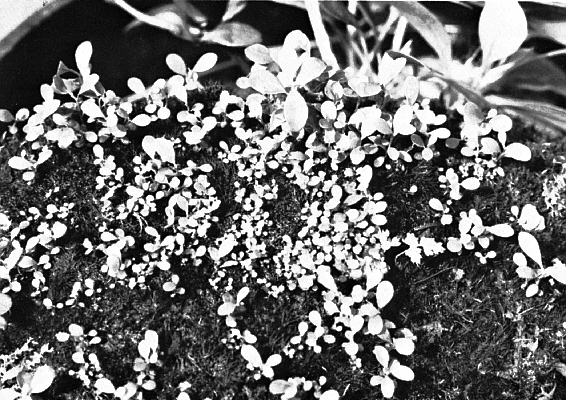QBARS - v32n1 To Water or Not To Water
To Water or Not to Water
Brian Clancy, Melbourne, Australia
Reprinted with permission from "The Rhododendron" Quarterly
of the Australian Rhododendron Society
Separate schools of thought exist on whether water should be withheld from Malesian or Vireya Section Rhododendrons in the Summer months to obtain earlier blooming from seedlings. However, twelve thousand self-sown Malesian seedlings in the glasshouse at Olinda surely demonstrate that best results are obtained with Malesian rhododendrons when they are regularly and frequently watered.
It is interesting to note that Malesian rhododendrons are tolerant of extreme wet conditions. Apart from the small leafed species from high altitudes and alpine areas which in the wild are continuously wet with mists and frequent rains, most of the remaining Malesians are also extremely tolerant of very dry or drought conditions.
One of our leading growers of Malesians, Dr. John Rouse, of Toorak, has an outstanding connoisseur's garden where large numbers of Malesian rhododendrons are grown in the ground. It is important to note that most of the plants in this garden are watered automatically every second day. In addition, automatic overhead misting operates in hot weather when the leaf temperature reaches a pre-determined reading. Ten magnificent deep yellow flowered plants of R. laetum , about a dozen plants of the red flowered R. lochiae , a number of six foot R. javanicum with brilliant orange flowers, spectacular bi-colored R. zoelleri and many other Malesian species testify to this luxurious treatment.
On the other hand, Dr. Rouse has adopted an American practice of withholding water from Malesian seedlings to obtain earlier flowering. These plants are kept as dry as possible and are only watered when they are wilting and obviously distressed. Only then are they sparingly watered and the cycle of withholding water repeated. All this unusual treatment is done to obtain earlier flowers and it is not necessary as cutting grown plants obtained from Malesian seedlings will generally flower in three years without any special treatment.
It is generally well known that cutting grown plants of most genera will flower well before the seedling grown plant. A classic example of this is contained in an article on "Asiatic Magnolias in a Cornish Garden" by Nigel Holman on page 73 of "Rhododendrons 1971', of The Royal Horticultural Society, London. In this article Nigel Holman relates that Magnolia campbellii has the well deserved reputation of taking thirty years or more to flower from seed. In 1953, his father obtained a layer of M. campbellii and this created surprise by flowering in 1969, admittedly with only three flowers, but showing that a layer (i.e. a cutting grown plant) could be the answer for the impatient. In other words, a wait of more than thirty years reduced by 50 percent with a cutting grown plant.
Several hundred Malesian rhododendrons are growing in fern logs in the glasshouse at Olinda. These plants, the growing medium and the atmosphere are kept continually moist in the summer months by a sprinkler system which is usually turned on for about an hour each day. A fair indication that the Malesians appreciate these conditions is that they flower profusely throughout the year. In addition, it is carefully estimated that in summer 1977 more than twelve thousand seedlings were growing naturally on the fern logs where the seed had fallen from the parent plants and germinated in the ideal conditions. As illustrated, on one piece of fern log some eight inches by six inches were some six hundred seedlings enjoying the moist conditions.

|
|
Natural Malesian seedlings which germinated on fern log.
Photo by Arthur Headlam |
One of the problems with the water supply in the glasshouse at Olinda, is not the quantity of the water but its purity. The water is pumped from the dam in the garden and originated from a spring. With overhead sprinklers this water precipitates a red deposit which is clearly visible as it builds up on the leaves. The leaves then tend to droop as the deposit builds up and interferes with transpiration. This problem is alleviated if the plants are given a spell outside the glasshouse where they can be washed by natural rain water, however, this is a difficult task with such a large number of plants. One solution if the provision of a suitable filter in the pipe line but this is of doubtful benefit as the precipitation is so extremely fine. Probably the best solution is to correct to the reticulated water supply.
Best results are obtained with Malesian rhododendrons when they are regularly watered. Adequate moisture together with optimum sunlight ensures quantity and quality of flowers. In addition, advantage of their tolerance to dry conditions can be taken when water restrictions apply. Fern fiber does not readily dry out and the twelve thousand self sown seedlings in the glasshouse at Olinda clearly indicates this medium for rare or more hasten blooming of seedlings by up to fifty percent.
